Human Resource Management
VerifiedAdded on 2023/05/31
|15
|3362
|228
AI Summary
This article discusses the importance of training and development, employee orientation, and socialization in human resource management. It also explores ways managers can assist in employee career development and the role of mentoring in training and development. The article includes a template for employee orientation and socialization and provides an overview of the training and development opportunities available in an organization.
Contribute Materials
Your contribution can guide someone’s learning journey. Share your
documents today.
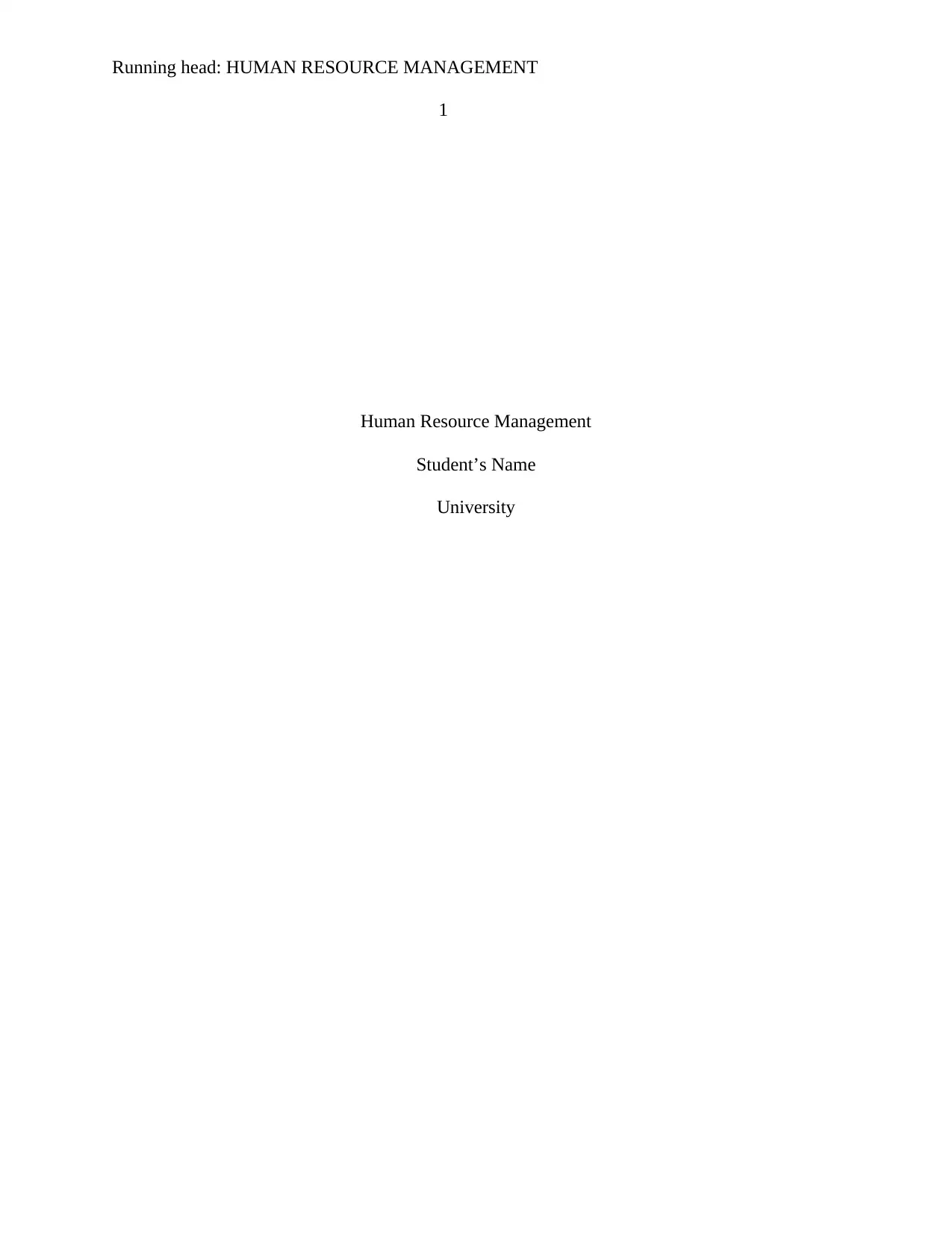
Running head: HUMAN RESOURCE MANAGEMENT
1
Human Resource Management
Student’s Name
University
1
Human Resource Management
Student’s Name
University
Secure Best Marks with AI Grader
Need help grading? Try our AI Grader for instant feedback on your assignments.
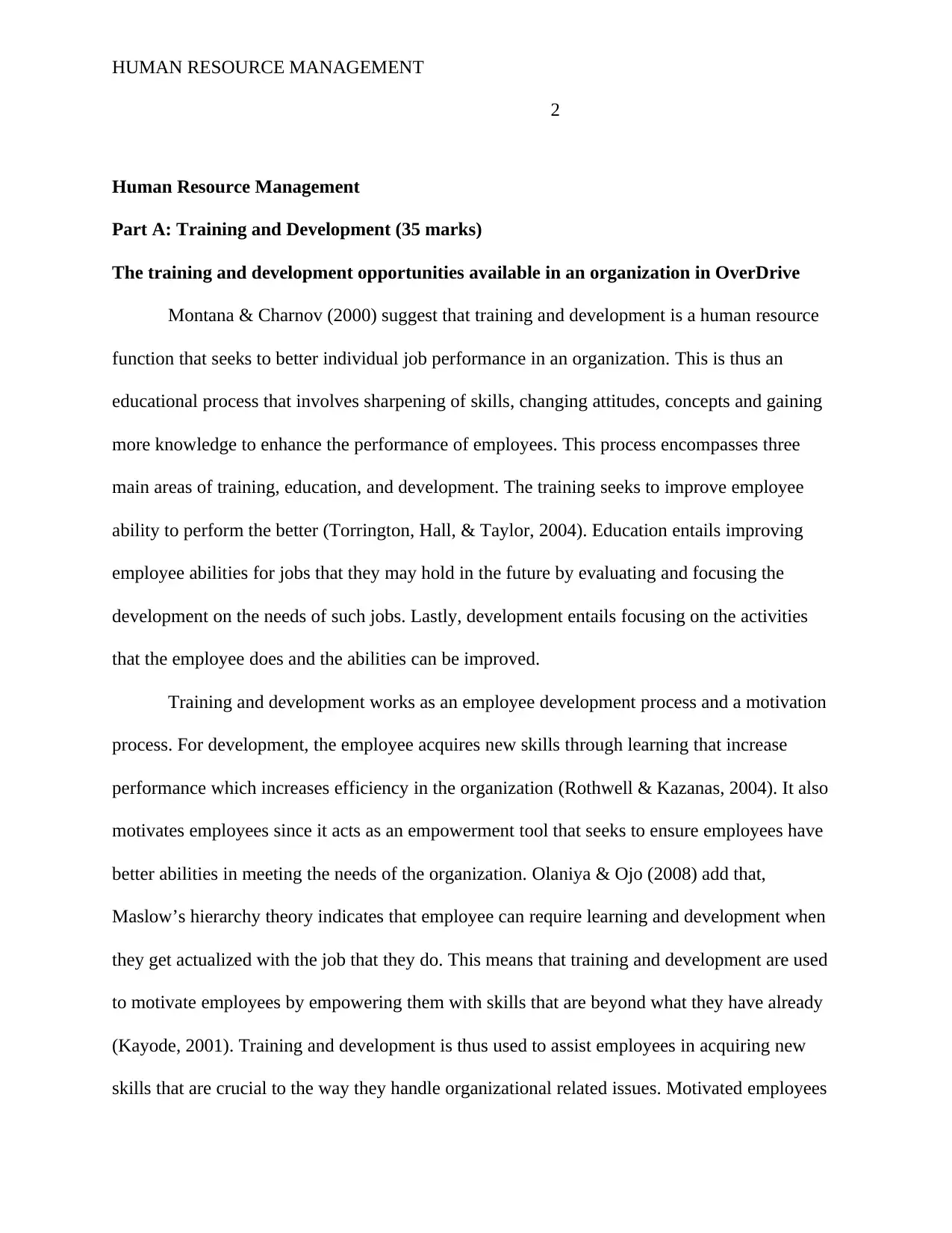
HUMAN RESOURCE MANAGEMENT
2
Human Resource Management
Part A: Training and Development (35 marks)
The training and development opportunities available in an organization in OverDrive
Montana & Charnov (2000) suggest that training and development is a human resource
function that seeks to better individual job performance in an organization. This is thus an
educational process that involves sharpening of skills, changing attitudes, concepts and gaining
more knowledge to enhance the performance of employees. This process encompasses three
main areas of training, education, and development. The training seeks to improve employee
ability to perform the better (Torrington, Hall, & Taylor, 2004). Education entails improving
employee abilities for jobs that they may hold in the future by evaluating and focusing the
development on the needs of such jobs. Lastly, development entails focusing on the activities
that the employee does and the abilities can be improved.
Training and development works as an employee development process and a motivation
process. For development, the employee acquires new skills through learning that increase
performance which increases efficiency in the organization (Rothwell & Kazanas, 2004). It also
motivates employees since it acts as an empowerment tool that seeks to ensure employees have
better abilities in meeting the needs of the organization. Olaniya & Ojo (2008) add that,
Maslow’s hierarchy theory indicates that employee can require learning and development when
they get actualized with the job that they do. This means that training and development are used
to motivate employees by empowering them with skills that are beyond what they have already
(Kayode, 2001). Training and development is thus used to assist employees in acquiring new
skills that are crucial to the way they handle organizational related issues. Motivated employees
2
Human Resource Management
Part A: Training and Development (35 marks)
The training and development opportunities available in an organization in OverDrive
Montana & Charnov (2000) suggest that training and development is a human resource
function that seeks to better individual job performance in an organization. This is thus an
educational process that involves sharpening of skills, changing attitudes, concepts and gaining
more knowledge to enhance the performance of employees. This process encompasses three
main areas of training, education, and development. The training seeks to improve employee
ability to perform the better (Torrington, Hall, & Taylor, 2004). Education entails improving
employee abilities for jobs that they may hold in the future by evaluating and focusing the
development on the needs of such jobs. Lastly, development entails focusing on the activities
that the employee does and the abilities can be improved.
Training and development works as an employee development process and a motivation
process. For development, the employee acquires new skills through learning that increase
performance which increases efficiency in the organization (Rothwell & Kazanas, 2004). It also
motivates employees since it acts as an empowerment tool that seeks to ensure employees have
better abilities in meeting the needs of the organization. Olaniya & Ojo (2008) add that,
Maslow’s hierarchy theory indicates that employee can require learning and development when
they get actualized with the job that they do. This means that training and development are used
to motivate employees by empowering them with skills that are beyond what they have already
(Kayode, 2001). Training and development is thus used to assist employees in acquiring new
skills that are crucial to the way they handle organizational related issues. Motivated employees
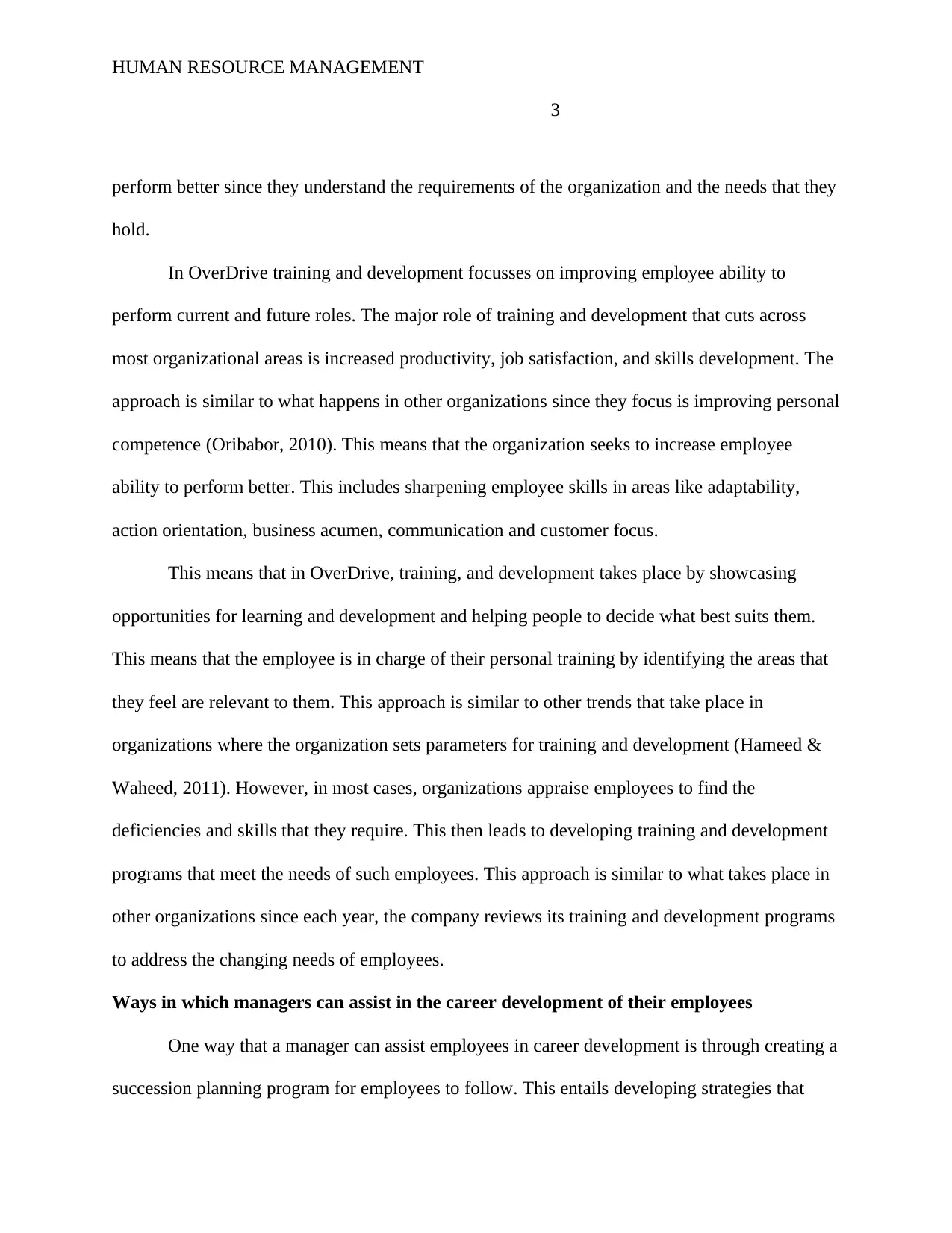
HUMAN RESOURCE MANAGEMENT
3
perform better since they understand the requirements of the organization and the needs that they
hold.
In OverDrive training and development focusses on improving employee ability to
perform current and future roles. The major role of training and development that cuts across
most organizational areas is increased productivity, job satisfaction, and skills development. The
approach is similar to what happens in other organizations since they focus is improving personal
competence (Oribabor, 2010). This means that the organization seeks to increase employee
ability to perform better. This includes sharpening employee skills in areas like adaptability,
action orientation, business acumen, communication and customer focus.
This means that in OverDrive, training, and development takes place by showcasing
opportunities for learning and development and helping people to decide what best suits them.
This means that the employee is in charge of their personal training by identifying the areas that
they feel are relevant to them. This approach is similar to other trends that take place in
organizations where the organization sets parameters for training and development (Hameed &
Waheed, 2011). However, in most cases, organizations appraise employees to find the
deficiencies and skills that they require. This then leads to developing training and development
programs that meet the needs of such employees. This approach is similar to what takes place in
other organizations since each year, the company reviews its training and development programs
to address the changing needs of employees.
Ways in which managers can assist in the career development of their employees
One way that a manager can assist employees in career development is through creating a
succession planning program for employees to follow. This entails developing strategies that
3
perform better since they understand the requirements of the organization and the needs that they
hold.
In OverDrive training and development focusses on improving employee ability to
perform current and future roles. The major role of training and development that cuts across
most organizational areas is increased productivity, job satisfaction, and skills development. The
approach is similar to what happens in other organizations since they focus is improving personal
competence (Oribabor, 2010). This means that the organization seeks to increase employee
ability to perform better. This includes sharpening employee skills in areas like adaptability,
action orientation, business acumen, communication and customer focus.
This means that in OverDrive, training, and development takes place by showcasing
opportunities for learning and development and helping people to decide what best suits them.
This means that the employee is in charge of their personal training by identifying the areas that
they feel are relevant to them. This approach is similar to other trends that take place in
organizations where the organization sets parameters for training and development (Hameed &
Waheed, 2011). However, in most cases, organizations appraise employees to find the
deficiencies and skills that they require. This then leads to developing training and development
programs that meet the needs of such employees. This approach is similar to what takes place in
other organizations since each year, the company reviews its training and development programs
to address the changing needs of employees.
Ways in which managers can assist in the career development of their employees
One way that a manager can assist employees in career development is through creating a
succession planning program for employees to follow. This entails developing strategies that
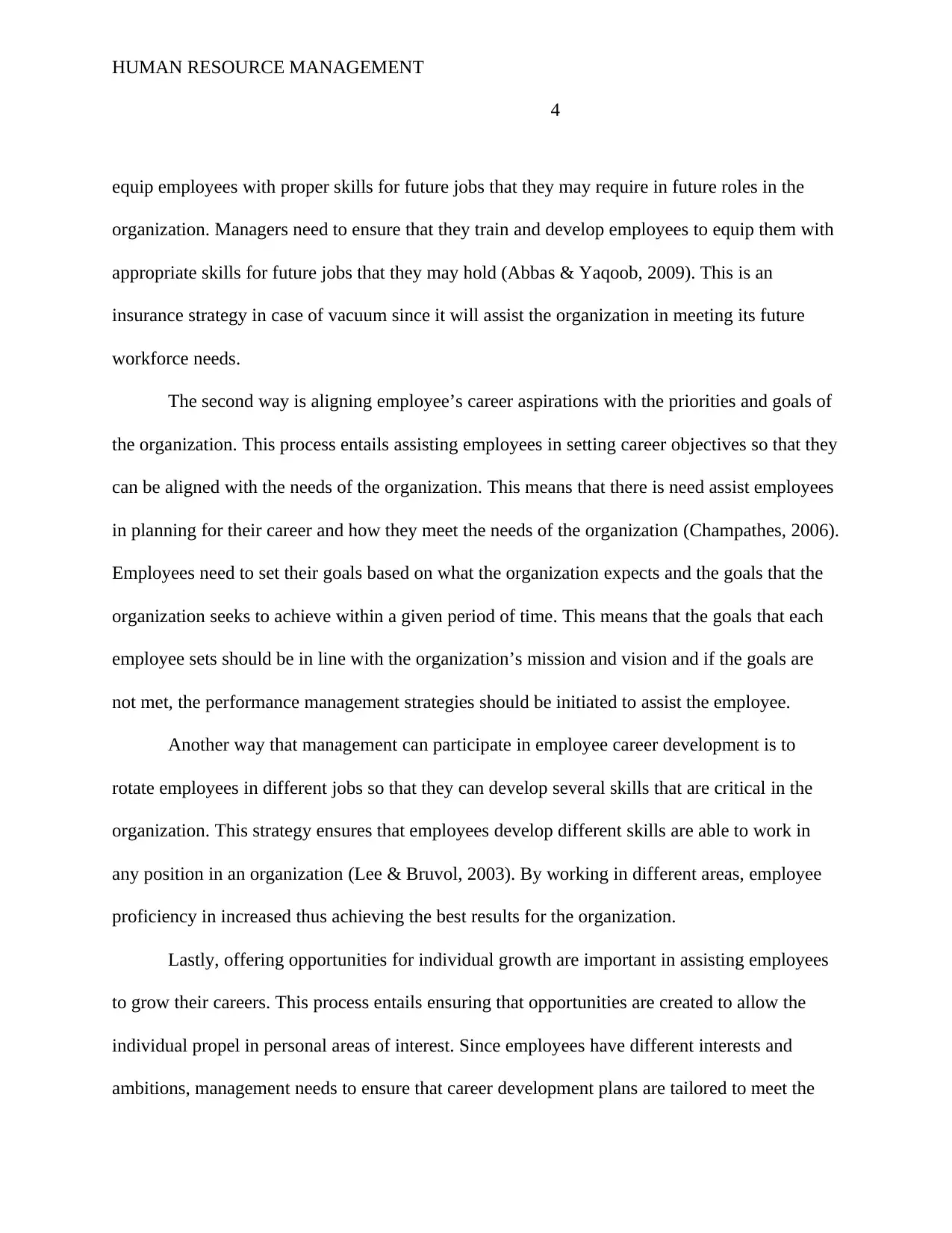
HUMAN RESOURCE MANAGEMENT
4
equip employees with proper skills for future jobs that they may require in future roles in the
organization. Managers need to ensure that they train and develop employees to equip them with
appropriate skills for future jobs that they may hold (Abbas & Yaqoob, 2009). This is an
insurance strategy in case of vacuum since it will assist the organization in meeting its future
workforce needs.
The second way is aligning employee’s career aspirations with the priorities and goals of
the organization. This process entails assisting employees in setting career objectives so that they
can be aligned with the needs of the organization. This means that there is need assist employees
in planning for their career and how they meet the needs of the organization (Champathes, 2006).
Employees need to set their goals based on what the organization expects and the goals that the
organization seeks to achieve within a given period of time. This means that the goals that each
employee sets should be in line with the organization’s mission and vision and if the goals are
not met, the performance management strategies should be initiated to assist the employee.
Another way that management can participate in employee career development is to
rotate employees in different jobs so that they can develop several skills that are critical in the
organization. This strategy ensures that employees develop different skills are able to work in
any position in an organization (Lee & Bruvol, 2003). By working in different areas, employee
proficiency in increased thus achieving the best results for the organization.
Lastly, offering opportunities for individual growth are important in assisting employees
to grow their careers. This process entails ensuring that opportunities are created to allow the
individual propel in personal areas of interest. Since employees have different interests and
ambitions, management needs to ensure that career development plans are tailored to meet the
4
equip employees with proper skills for future jobs that they may require in future roles in the
organization. Managers need to ensure that they train and develop employees to equip them with
appropriate skills for future jobs that they may hold (Abbas & Yaqoob, 2009). This is an
insurance strategy in case of vacuum since it will assist the organization in meeting its future
workforce needs.
The second way is aligning employee’s career aspirations with the priorities and goals of
the organization. This process entails assisting employees in setting career objectives so that they
can be aligned with the needs of the organization. This means that there is need assist employees
in planning for their career and how they meet the needs of the organization (Champathes, 2006).
Employees need to set their goals based on what the organization expects and the goals that the
organization seeks to achieve within a given period of time. This means that the goals that each
employee sets should be in line with the organization’s mission and vision and if the goals are
not met, the performance management strategies should be initiated to assist the employee.
Another way that management can participate in employee career development is to
rotate employees in different jobs so that they can develop several skills that are critical in the
organization. This strategy ensures that employees develop different skills are able to work in
any position in an organization (Lee & Bruvol, 2003). By working in different areas, employee
proficiency in increased thus achieving the best results for the organization.
Lastly, offering opportunities for individual growth are important in assisting employees
to grow their careers. This process entails ensuring that opportunities are created to allow the
individual propel in personal areas of interest. Since employees have different interests and
ambitions, management needs to ensure that career development plans are tailored to meet the
Secure Best Marks with AI Grader
Need help grading? Try our AI Grader for instant feedback on your assignments.
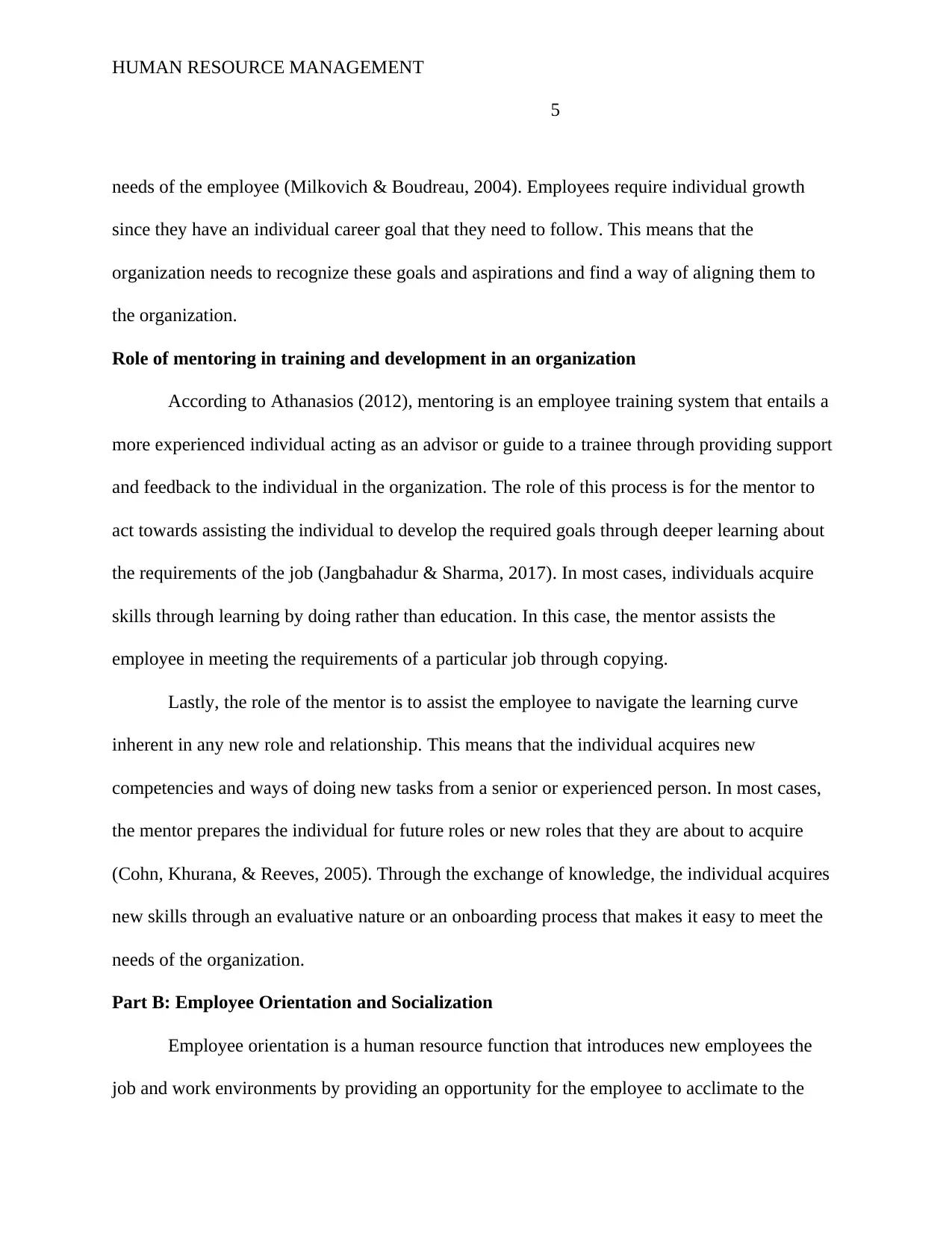
HUMAN RESOURCE MANAGEMENT
5
needs of the employee (Milkovich & Boudreau, 2004). Employees require individual growth
since they have an individual career goal that they need to follow. This means that the
organization needs to recognize these goals and aspirations and find a way of aligning them to
the organization.
Role of mentoring in training and development in an organization
According to Athanasios (2012), mentoring is an employee training system that entails a
more experienced individual acting as an advisor or guide to a trainee through providing support
and feedback to the individual in the organization. The role of this process is for the mentor to
act towards assisting the individual to develop the required goals through deeper learning about
the requirements of the job (Jangbahadur & Sharma, 2017). In most cases, individuals acquire
skills through learning by doing rather than education. In this case, the mentor assists the
employee in meeting the requirements of a particular job through copying.
Lastly, the role of the mentor is to assist the employee to navigate the learning curve
inherent in any new role and relationship. This means that the individual acquires new
competencies and ways of doing new tasks from a senior or experienced person. In most cases,
the mentor prepares the individual for future roles or new roles that they are about to acquire
(Cohn, Khurana, & Reeves, 2005). Through the exchange of knowledge, the individual acquires
new skills through an evaluative nature or an onboarding process that makes it easy to meet the
needs of the organization.
Part B: Employee Orientation and Socialization
Employee orientation is a human resource function that introduces new employees the
job and work environments by providing an opportunity for the employee to acclimate to the
5
needs of the employee (Milkovich & Boudreau, 2004). Employees require individual growth
since they have an individual career goal that they need to follow. This means that the
organization needs to recognize these goals and aspirations and find a way of aligning them to
the organization.
Role of mentoring in training and development in an organization
According to Athanasios (2012), mentoring is an employee training system that entails a
more experienced individual acting as an advisor or guide to a trainee through providing support
and feedback to the individual in the organization. The role of this process is for the mentor to
act towards assisting the individual to develop the required goals through deeper learning about
the requirements of the job (Jangbahadur & Sharma, 2017). In most cases, individuals acquire
skills through learning by doing rather than education. In this case, the mentor assists the
employee in meeting the requirements of a particular job through copying.
Lastly, the role of the mentor is to assist the employee to navigate the learning curve
inherent in any new role and relationship. This means that the individual acquires new
competencies and ways of doing new tasks from a senior or experienced person. In most cases,
the mentor prepares the individual for future roles or new roles that they are about to acquire
(Cohn, Khurana, & Reeves, 2005). Through the exchange of knowledge, the individual acquires
new skills through an evaluative nature or an onboarding process that makes it easy to meet the
needs of the organization.
Part B: Employee Orientation and Socialization
Employee orientation is a human resource function that introduces new employees the
job and work environments by providing an opportunity for the employee to acclimate to the
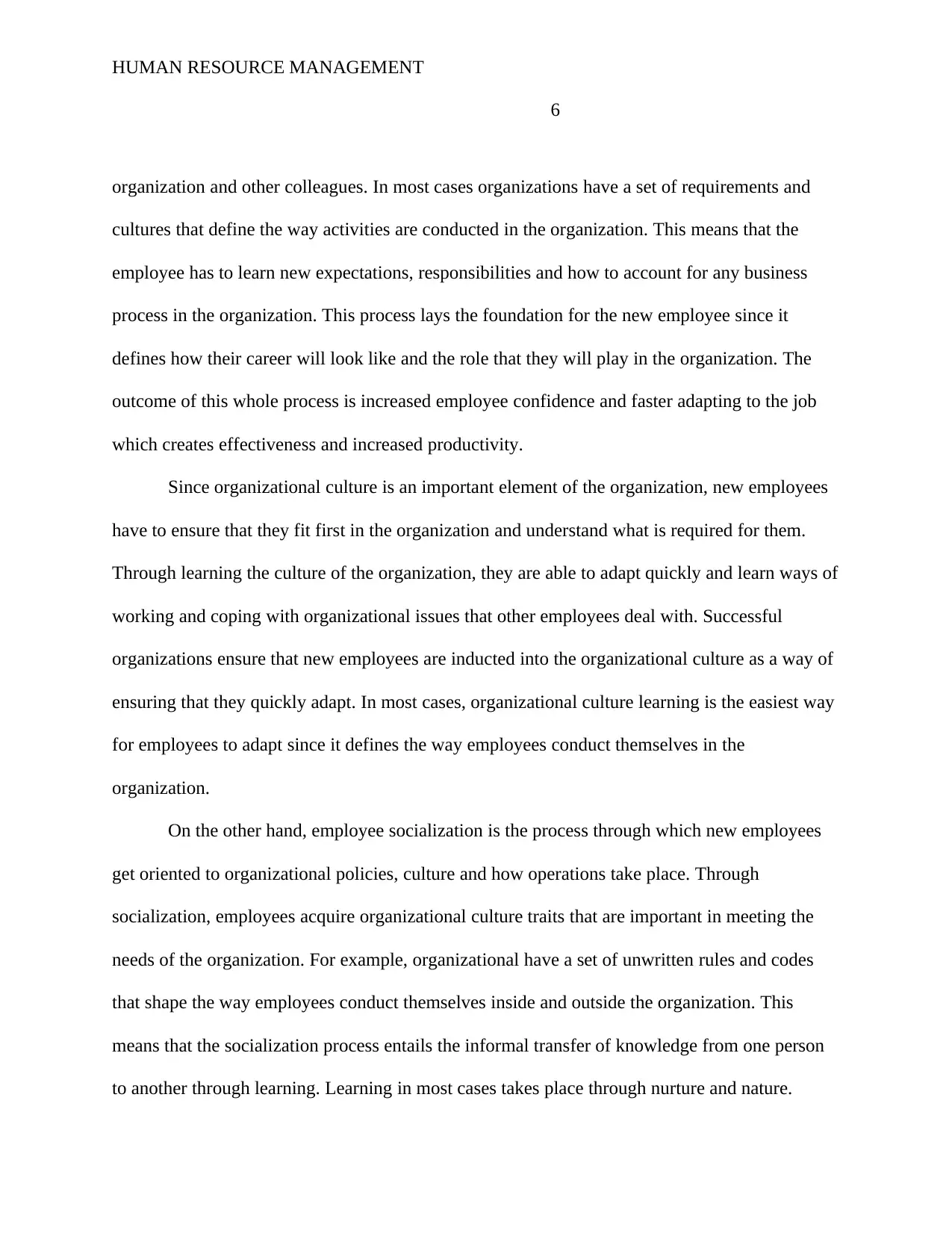
HUMAN RESOURCE MANAGEMENT
6
organization and other colleagues. In most cases organizations have a set of requirements and
cultures that define the way activities are conducted in the organization. This means that the
employee has to learn new expectations, responsibilities and how to account for any business
process in the organization. This process lays the foundation for the new employee since it
defines how their career will look like and the role that they will play in the organization. The
outcome of this whole process is increased employee confidence and faster adapting to the job
which creates effectiveness and increased productivity.
Since organizational culture is an important element of the organization, new employees
have to ensure that they fit first in the organization and understand what is required for them.
Through learning the culture of the organization, they are able to adapt quickly and learn ways of
working and coping with organizational issues that other employees deal with. Successful
organizations ensure that new employees are inducted into the organizational culture as a way of
ensuring that they quickly adapt. In most cases, organizational culture learning is the easiest way
for employees to adapt since it defines the way employees conduct themselves in the
organization.
On the other hand, employee socialization is the process through which new employees
get oriented to organizational policies, culture and how operations take place. Through
socialization, employees acquire organizational culture traits that are important in meeting the
needs of the organization. For example, organizational have a set of unwritten rules and codes
that shape the way employees conduct themselves inside and outside the organization. This
means that the socialization process entails the informal transfer of knowledge from one person
to another through learning. Learning in most cases takes place through nurture and nature.
6
organization and other colleagues. In most cases organizations have a set of requirements and
cultures that define the way activities are conducted in the organization. This means that the
employee has to learn new expectations, responsibilities and how to account for any business
process in the organization. This process lays the foundation for the new employee since it
defines how their career will look like and the role that they will play in the organization. The
outcome of this whole process is increased employee confidence and faster adapting to the job
which creates effectiveness and increased productivity.
Since organizational culture is an important element of the organization, new employees
have to ensure that they fit first in the organization and understand what is required for them.
Through learning the culture of the organization, they are able to adapt quickly and learn ways of
working and coping with organizational issues that other employees deal with. Successful
organizations ensure that new employees are inducted into the organizational culture as a way of
ensuring that they quickly adapt. In most cases, organizational culture learning is the easiest way
for employees to adapt since it defines the way employees conduct themselves in the
organization.
On the other hand, employee socialization is the process through which new employees
get oriented to organizational policies, culture and how operations take place. Through
socialization, employees acquire organizational culture traits that are important in meeting the
needs of the organization. For example, organizational have a set of unwritten rules and codes
that shape the way employees conduct themselves inside and outside the organization. This
means that the socialization process entails the informal transfer of knowledge from one person
to another through learning. Learning in most cases takes place through nurture and nature.
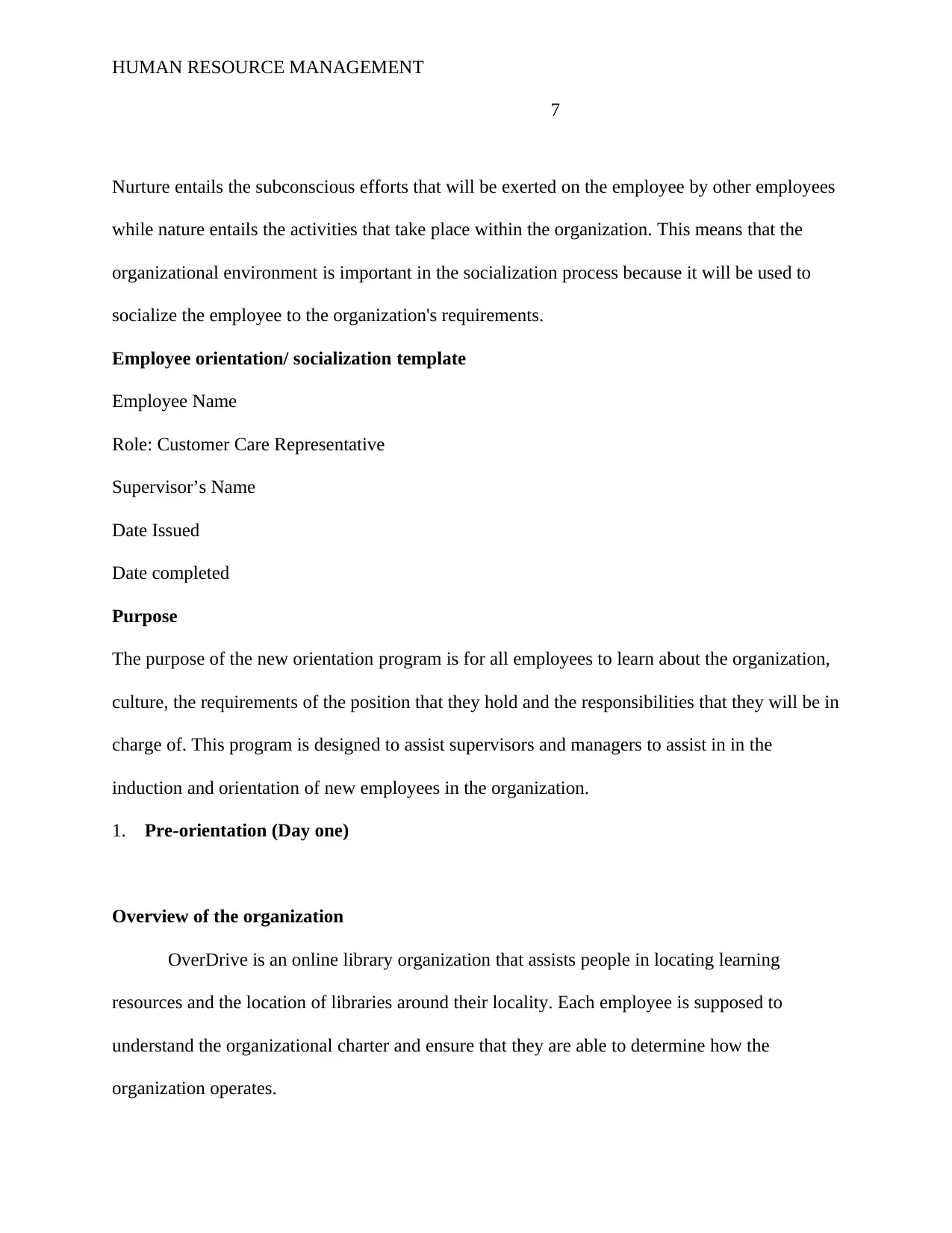
HUMAN RESOURCE MANAGEMENT
7
Nurture entails the subconscious efforts that will be exerted on the employee by other employees
while nature entails the activities that take place within the organization. This means that the
organizational environment is important in the socialization process because it will be used to
socialize the employee to the organization's requirements.
Employee orientation/ socialization template
Employee Name
Role: Customer Care Representative
Supervisor’s Name
Date Issued
Date completed
Purpose
The purpose of the new orientation program is for all employees to learn about the organization,
culture, the requirements of the position that they hold and the responsibilities that they will be in
charge of. This program is designed to assist supervisors and managers to assist in in the
induction and orientation of new employees in the organization.
1. Pre-orientation (Day one)
Overview of the organization
OverDrive is an online library organization that assists people in locating learning
resources and the location of libraries around their locality. Each employee is supposed to
understand the organizational charter and ensure that they are able to determine how the
organization operates.
7
Nurture entails the subconscious efforts that will be exerted on the employee by other employees
while nature entails the activities that take place within the organization. This means that the
organizational environment is important in the socialization process because it will be used to
socialize the employee to the organization's requirements.
Employee orientation/ socialization template
Employee Name
Role: Customer Care Representative
Supervisor’s Name
Date Issued
Date completed
Purpose
The purpose of the new orientation program is for all employees to learn about the organization,
culture, the requirements of the position that they hold and the responsibilities that they will be in
charge of. This program is designed to assist supervisors and managers to assist in in the
induction and orientation of new employees in the organization.
1. Pre-orientation (Day one)
Overview of the organization
OverDrive is an online library organization that assists people in locating learning
resources and the location of libraries around their locality. Each employee is supposed to
understand the organizational charter and ensure that they are able to determine how the
organization operates.
Paraphrase This Document
Need a fresh take? Get an instant paraphrase of this document with our AI Paraphraser
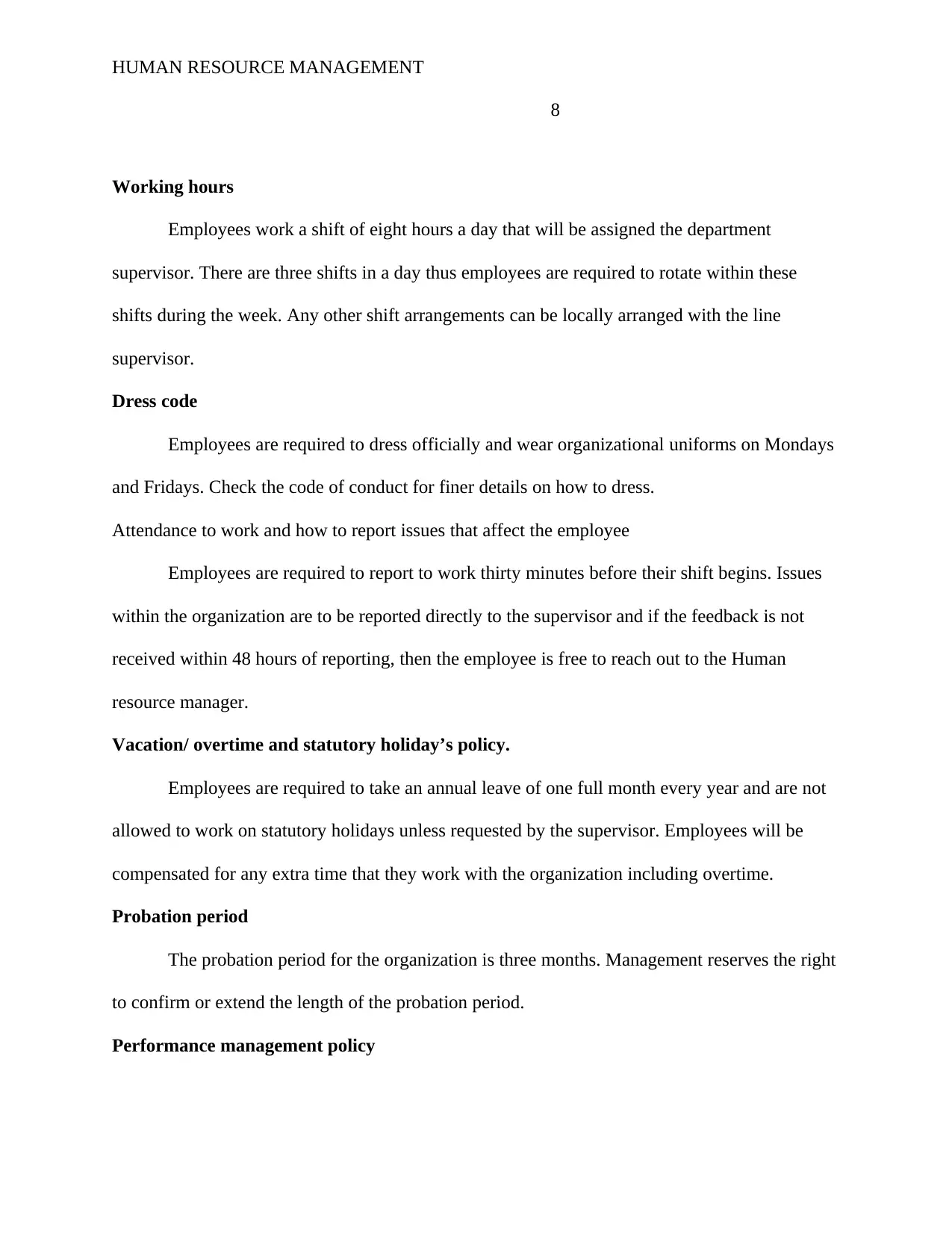
HUMAN RESOURCE MANAGEMENT
8
Working hours
Employees work a shift of eight hours a day that will be assigned the department
supervisor. There are three shifts in a day thus employees are required to rotate within these
shifts during the week. Any other shift arrangements can be locally arranged with the line
supervisor.
Dress code
Employees are required to dress officially and wear organizational uniforms on Mondays
and Fridays. Check the code of conduct for finer details on how to dress.
Attendance to work and how to report issues that affect the employee
Employees are required to report to work thirty minutes before their shift begins. Issues
within the organization are to be reported directly to the supervisor and if the feedback is not
received within 48 hours of reporting, then the employee is free to reach out to the Human
resource manager.
Vacation/ overtime and statutory holiday’s policy.
Employees are required to take an annual leave of one full month every year and are not
allowed to work on statutory holidays unless requested by the supervisor. Employees will be
compensated for any extra time that they work with the organization including overtime.
Probation period
The probation period for the organization is three months. Management reserves the right
to confirm or extend the length of the probation period.
Performance management policy
8
Working hours
Employees work a shift of eight hours a day that will be assigned the department
supervisor. There are three shifts in a day thus employees are required to rotate within these
shifts during the week. Any other shift arrangements can be locally arranged with the line
supervisor.
Dress code
Employees are required to dress officially and wear organizational uniforms on Mondays
and Fridays. Check the code of conduct for finer details on how to dress.
Attendance to work and how to report issues that affect the employee
Employees are required to report to work thirty minutes before their shift begins. Issues
within the organization are to be reported directly to the supervisor and if the feedback is not
received within 48 hours of reporting, then the employee is free to reach out to the Human
resource manager.
Vacation/ overtime and statutory holiday’s policy.
Employees are required to take an annual leave of one full month every year and are not
allowed to work on statutory holidays unless requested by the supervisor. Employees will be
compensated for any extra time that they work with the organization including overtime.
Probation period
The probation period for the organization is three months. Management reserves the right
to confirm or extend the length of the probation period.
Performance management policy
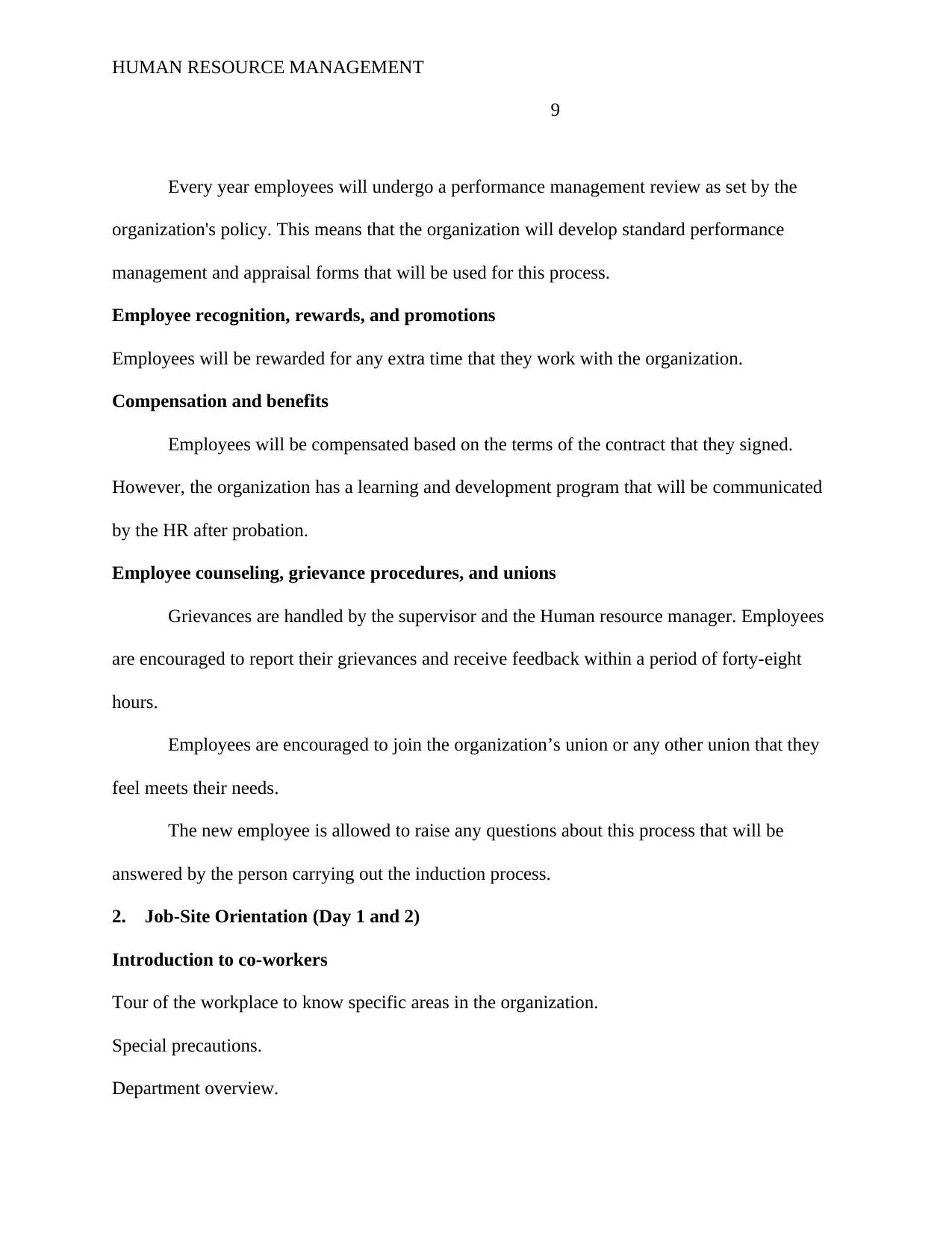
HUMAN RESOURCE MANAGEMENT
9
Every year employees will undergo a performance management review as set by the
organization's policy. This means that the organization will develop standard performance
management and appraisal forms that will be used for this process.
Employee recognition, rewards, and promotions
Employees will be rewarded for any extra time that they work with the organization.
Compensation and benefits
Employees will be compensated based on the terms of the contract that they signed.
However, the organization has a learning and development program that will be communicated
by the HR after probation.
Employee counseling, grievance procedures, and unions
Grievances are handled by the supervisor and the Human resource manager. Employees
are encouraged to report their grievances and receive feedback within a period of forty-eight
hours.
Employees are encouraged to join the organization’s union or any other union that they
feel meets their needs.
The new employee is allowed to raise any questions about this process that will be
answered by the person carrying out the induction process.
2. Job-Site Orientation (Day 1 and 2)
Introduction to co-workers
Tour of the workplace to know specific areas in the organization.
Special precautions.
Department overview.
9
Every year employees will undergo a performance management review as set by the
organization's policy. This means that the organization will develop standard performance
management and appraisal forms that will be used for this process.
Employee recognition, rewards, and promotions
Employees will be rewarded for any extra time that they work with the organization.
Compensation and benefits
Employees will be compensated based on the terms of the contract that they signed.
However, the organization has a learning and development program that will be communicated
by the HR after probation.
Employee counseling, grievance procedures, and unions
Grievances are handled by the supervisor and the Human resource manager. Employees
are encouraged to report their grievances and receive feedback within a period of forty-eight
hours.
Employees are encouraged to join the organization’s union or any other union that they
feel meets their needs.
The new employee is allowed to raise any questions about this process that will be
answered by the person carrying out the induction process.
2. Job-Site Orientation (Day 1 and 2)
Introduction to co-workers
Tour of the workplace to know specific areas in the organization.
Special precautions.
Department overview.
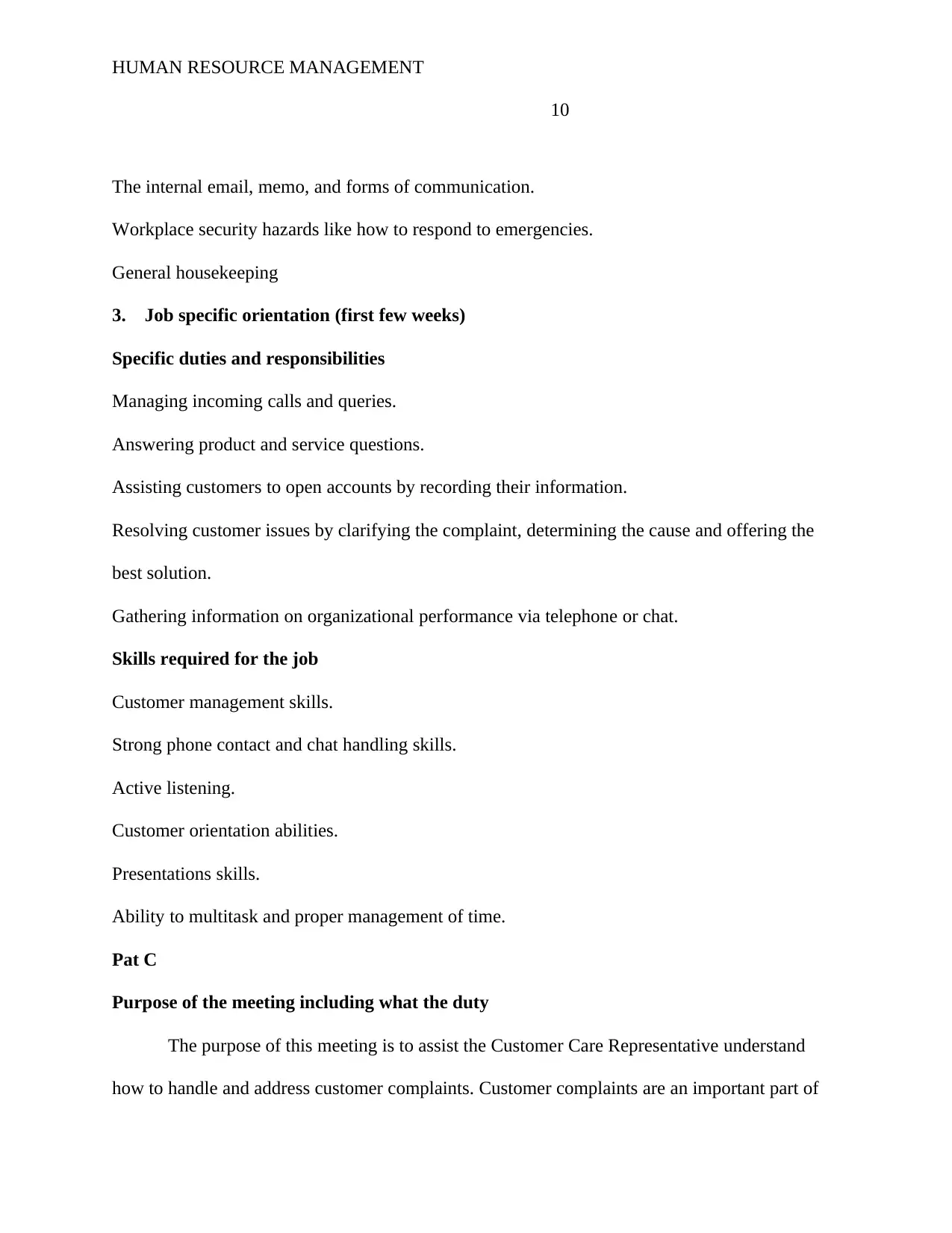
HUMAN RESOURCE MANAGEMENT
10
The internal email, memo, and forms of communication.
Workplace security hazards like how to respond to emergencies.
General housekeeping
3. Job specific orientation (first few weeks)
Specific duties and responsibilities
Managing incoming calls and queries.
Answering product and service questions.
Assisting customers to open accounts by recording their information.
Resolving customer issues by clarifying the complaint, determining the cause and offering the
best solution.
Gathering information on organizational performance via telephone or chat.
Skills required for the job
Customer management skills.
Strong phone contact and chat handling skills.
Active listening.
Customer orientation abilities.
Presentations skills.
Ability to multitask and proper management of time.
Pat C
Purpose of the meeting including what the duty
The purpose of this meeting is to assist the Customer Care Representative understand
how to handle and address customer complaints. Customer complaints are an important part of
10
The internal email, memo, and forms of communication.
Workplace security hazards like how to respond to emergencies.
General housekeeping
3. Job specific orientation (first few weeks)
Specific duties and responsibilities
Managing incoming calls and queries.
Answering product and service questions.
Assisting customers to open accounts by recording their information.
Resolving customer issues by clarifying the complaint, determining the cause and offering the
best solution.
Gathering information on organizational performance via telephone or chat.
Skills required for the job
Customer management skills.
Strong phone contact and chat handling skills.
Active listening.
Customer orientation abilities.
Presentations skills.
Ability to multitask and proper management of time.
Pat C
Purpose of the meeting including what the duty
The purpose of this meeting is to assist the Customer Care Representative understand
how to handle and address customer complaints. Customer complaints are an important part of
Secure Best Marks with AI Grader
Need help grading? Try our AI Grader for instant feedback on your assignments.
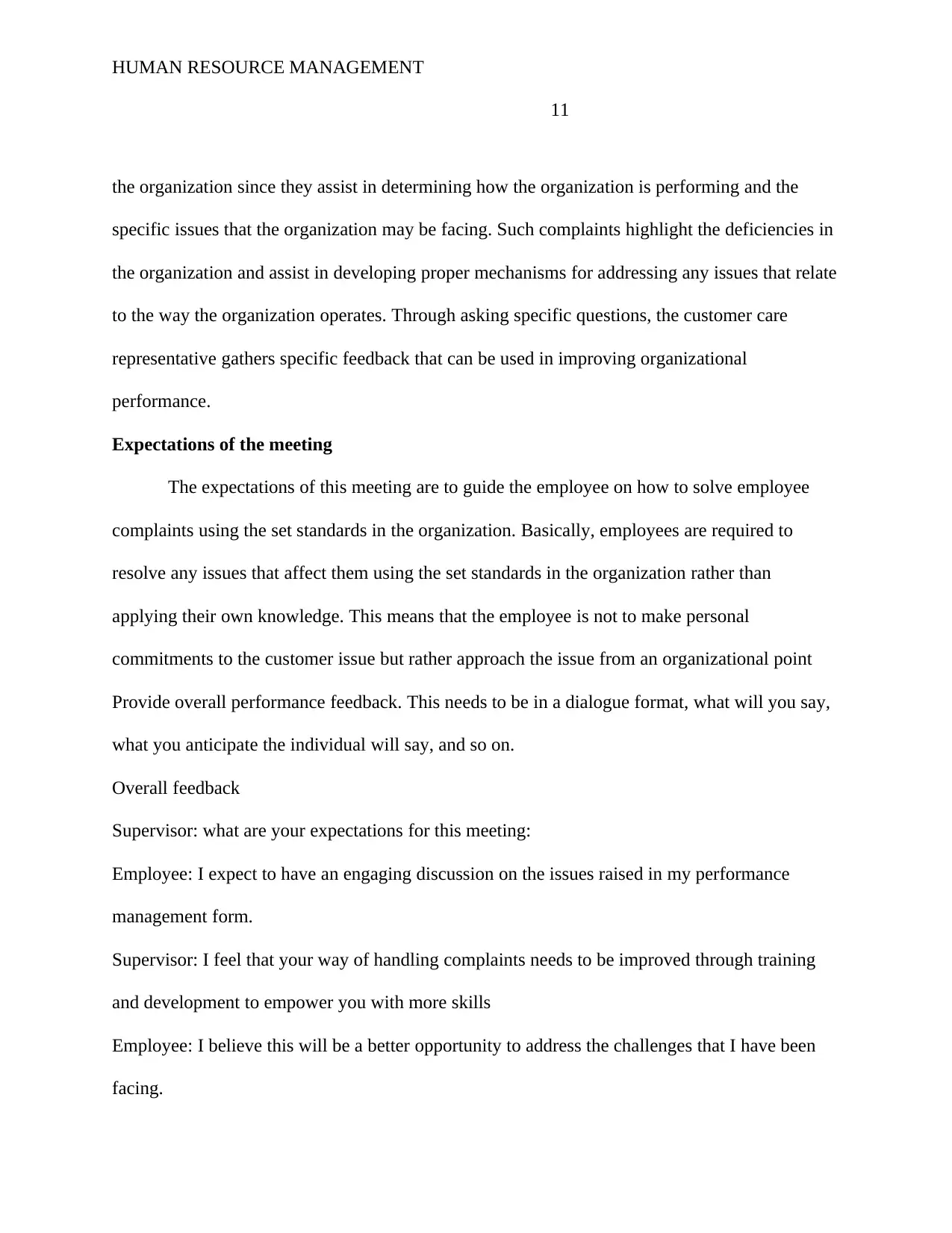
HUMAN RESOURCE MANAGEMENT
11
the organization since they assist in determining how the organization is performing and the
specific issues that the organization may be facing. Such complaints highlight the deficiencies in
the organization and assist in developing proper mechanisms for addressing any issues that relate
to the way the organization operates. Through asking specific questions, the customer care
representative gathers specific feedback that can be used in improving organizational
performance.
Expectations of the meeting
The expectations of this meeting are to guide the employee on how to solve employee
complaints using the set standards in the organization. Basically, employees are required to
resolve any issues that affect them using the set standards in the organization rather than
applying their own knowledge. This means that the employee is not to make personal
commitments to the customer issue but rather approach the issue from an organizational point
Provide overall performance feedback. This needs to be in a dialogue format, what will you say,
what you anticipate the individual will say, and so on.
Overall feedback
Supervisor: what are your expectations for this meeting:
Employee: I expect to have an engaging discussion on the issues raised in my performance
management form.
Supervisor: I feel that your way of handling complaints needs to be improved through training
and development to empower you with more skills
Employee: I believe this will be a better opportunity to address the challenges that I have been
facing.
11
the organization since they assist in determining how the organization is performing and the
specific issues that the organization may be facing. Such complaints highlight the deficiencies in
the organization and assist in developing proper mechanisms for addressing any issues that relate
to the way the organization operates. Through asking specific questions, the customer care
representative gathers specific feedback that can be used in improving organizational
performance.
Expectations of the meeting
The expectations of this meeting are to guide the employee on how to solve employee
complaints using the set standards in the organization. Basically, employees are required to
resolve any issues that affect them using the set standards in the organization rather than
applying their own knowledge. This means that the employee is not to make personal
commitments to the customer issue but rather approach the issue from an organizational point
Provide overall performance feedback. This needs to be in a dialogue format, what will you say,
what you anticipate the individual will say, and so on.
Overall feedback
Supervisor: what are your expectations for this meeting:
Employee: I expect to have an engaging discussion on the issues raised in my performance
management form.
Supervisor: I feel that your way of handling complaints needs to be improved through training
and development to empower you with more skills
Employee: I believe this will be a better opportunity to address the challenges that I have been
facing.
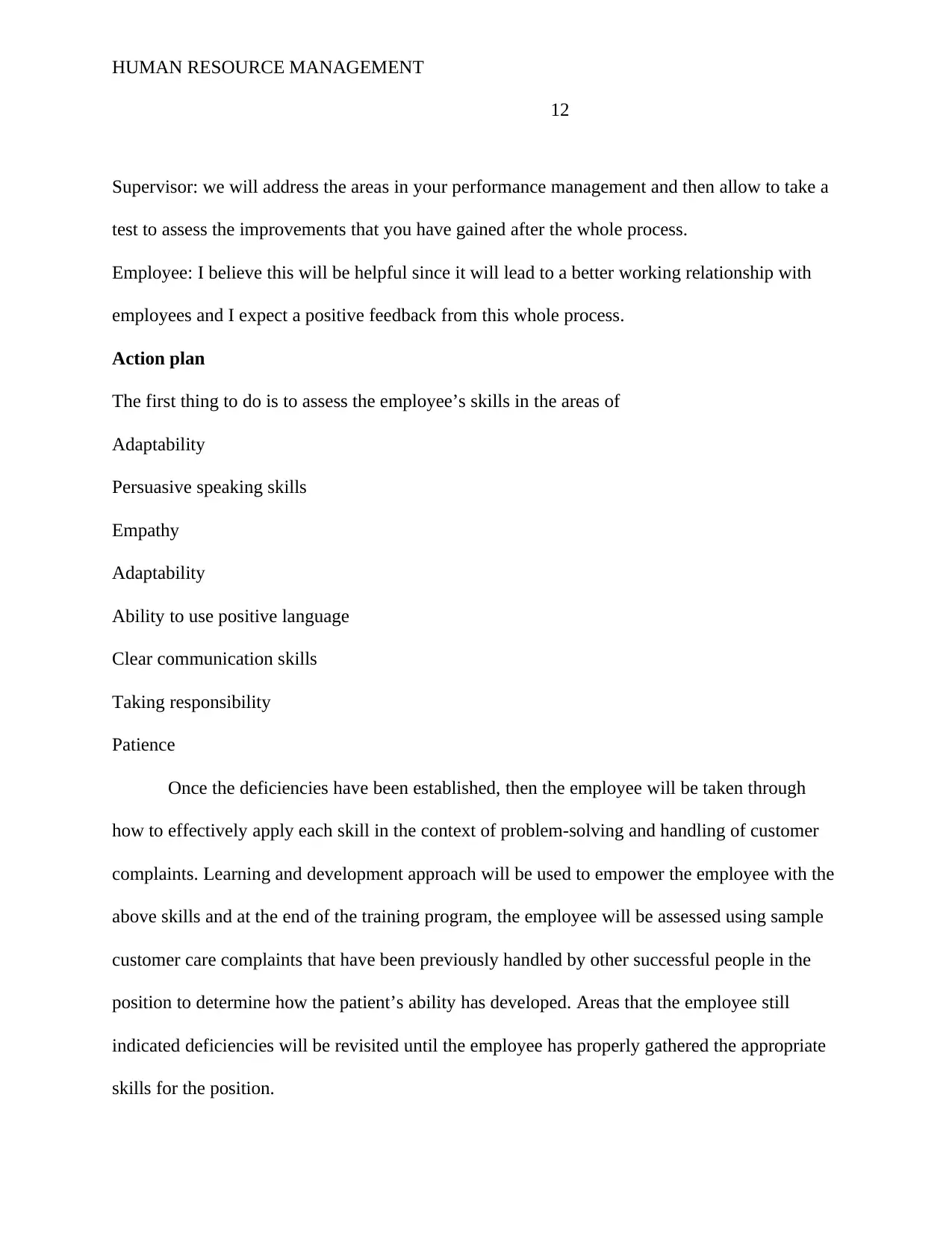
HUMAN RESOURCE MANAGEMENT
12
Supervisor: we will address the areas in your performance management and then allow to take a
test to assess the improvements that you have gained after the whole process.
Employee: I believe this will be helpful since it will lead to a better working relationship with
employees and I expect a positive feedback from this whole process.
Action plan
The first thing to do is to assess the employee’s skills in the areas of
Adaptability
Persuasive speaking skills
Empathy
Adaptability
Ability to use positive language
Clear communication skills
Taking responsibility
Patience
Once the deficiencies have been established, then the employee will be taken through
how to effectively apply each skill in the context of problem-solving and handling of customer
complaints. Learning and development approach will be used to empower the employee with the
above skills and at the end of the training program, the employee will be assessed using sample
customer care complaints that have been previously handled by other successful people in the
position to determine how the patient’s ability has developed. Areas that the employee still
indicated deficiencies will be revisited until the employee has properly gathered the appropriate
skills for the position.
12
Supervisor: we will address the areas in your performance management and then allow to take a
test to assess the improvements that you have gained after the whole process.
Employee: I believe this will be helpful since it will lead to a better working relationship with
employees and I expect a positive feedback from this whole process.
Action plan
The first thing to do is to assess the employee’s skills in the areas of
Adaptability
Persuasive speaking skills
Empathy
Adaptability
Ability to use positive language
Clear communication skills
Taking responsibility
Patience
Once the deficiencies have been established, then the employee will be taken through
how to effectively apply each skill in the context of problem-solving and handling of customer
complaints. Learning and development approach will be used to empower the employee with the
above skills and at the end of the training program, the employee will be assessed using sample
customer care complaints that have been previously handled by other successful people in the
position to determine how the patient’s ability has developed. Areas that the employee still
indicated deficiencies will be revisited until the employee has properly gathered the appropriate
skills for the position.
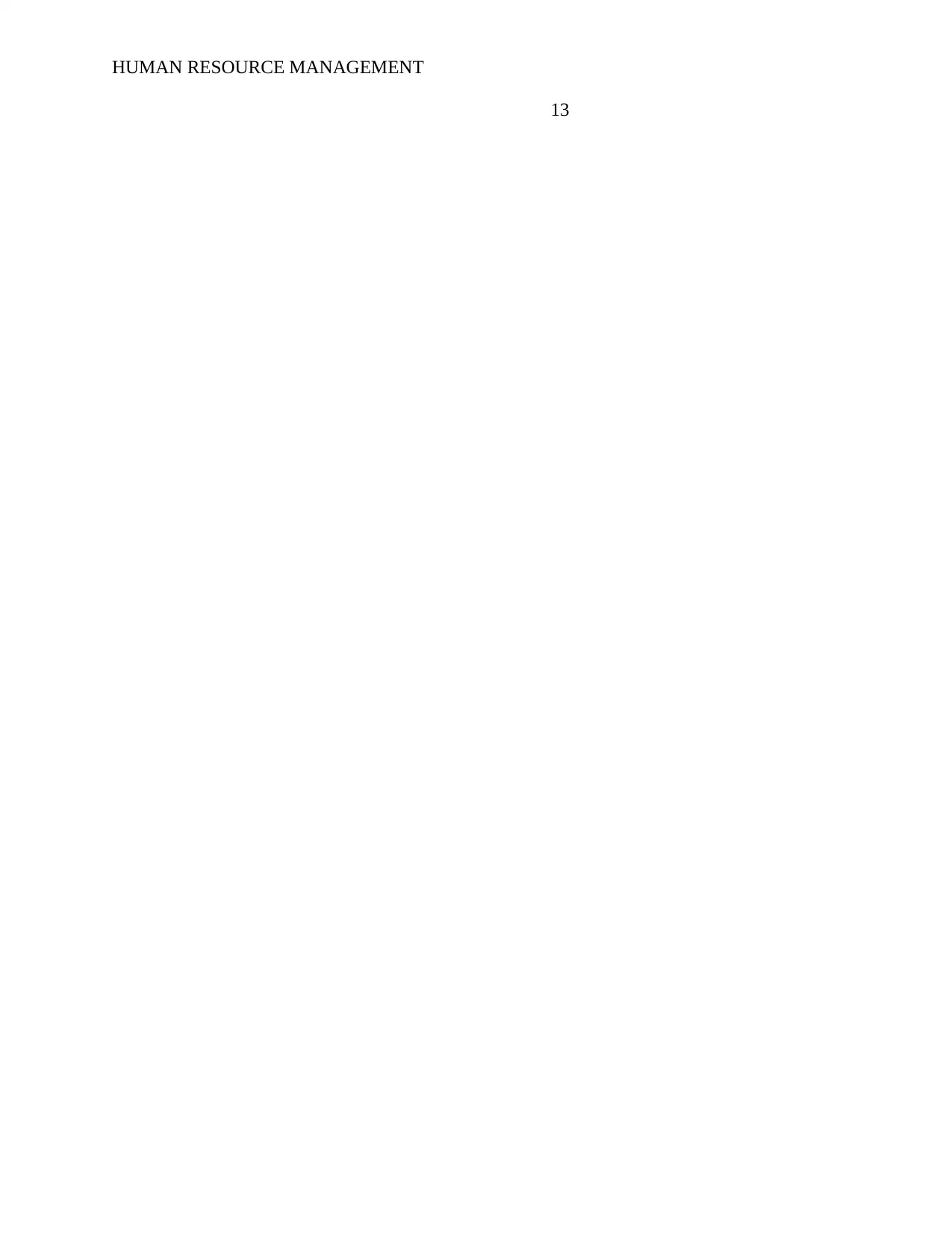
HUMAN RESOURCE MANAGEMENT
13
13
Paraphrase This Document
Need a fresh take? Get an instant paraphrase of this document with our AI Paraphraser
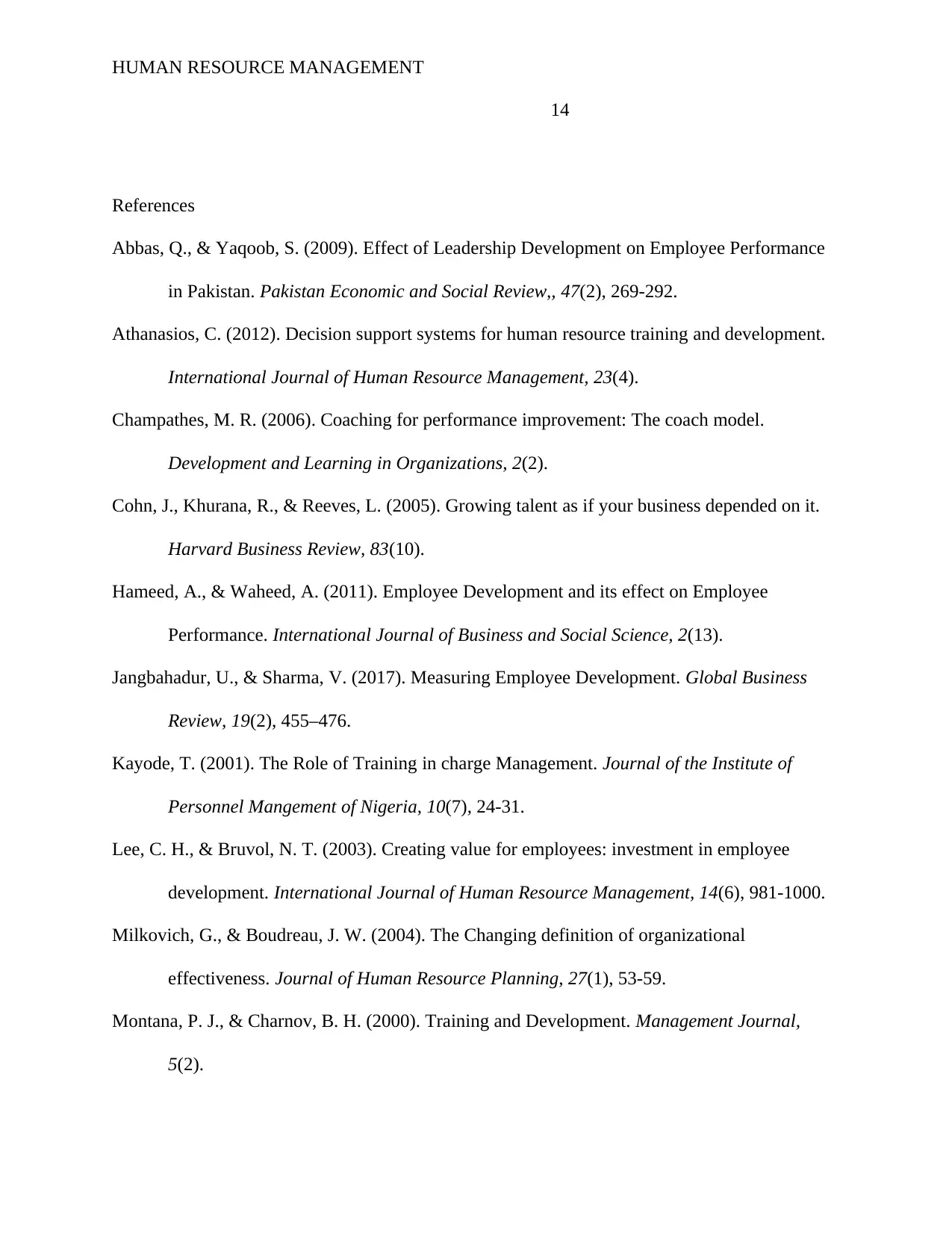
HUMAN RESOURCE MANAGEMENT
14
References
Abbas, Q., & Yaqoob, S. (2009). Effect of Leadership Development on Employee Performance
in Pakistan. Pakistan Economic and Social Review,, 47(2), 269-292.
Athanasios, C. (2012). Decision support systems for human resource training and development.
International Journal of Human Resource Management, 23(4).
Champathes, M. R. (2006). Coaching for performance improvement: The coach model.
Development and Learning in Organizations, 2(2).
Cohn, J., Khurana, R., & Reeves, L. (2005). Growing talent as if your business depended on it.
Harvard Business Review, 83(10).
Hameed, A., & Waheed, A. (2011). Employee Development and its effect on Employee
Performance. International Journal of Business and Social Science, 2(13).
Jangbahadur, U., & Sharma, V. (2017). Measuring Employee Development. Global Business
Review, 19(2), 455–476.
Kayode, T. (2001). The Role of Training in charge Management. Journal of the Institute of
Personnel Mangement of Nigeria, 10(7), 24-31.
Lee, C. H., & Bruvol, N. T. (2003). Creating value for employees: investment in employee
development. International Journal of Human Resource Management, 14(6), 981-1000.
Milkovich, G., & Boudreau, J. W. (2004). The Changing definition of organizational
effectiveness. Journal of Human Resource Planning, 27(1), 53-59.
Montana, P. J., & Charnov, B. H. (2000). Training and Development. Management Journal,
5(2).
14
References
Abbas, Q., & Yaqoob, S. (2009). Effect of Leadership Development on Employee Performance
in Pakistan. Pakistan Economic and Social Review,, 47(2), 269-292.
Athanasios, C. (2012). Decision support systems for human resource training and development.
International Journal of Human Resource Management, 23(4).
Champathes, M. R. (2006). Coaching for performance improvement: The coach model.
Development and Learning in Organizations, 2(2).
Cohn, J., Khurana, R., & Reeves, L. (2005). Growing talent as if your business depended on it.
Harvard Business Review, 83(10).
Hameed, A., & Waheed, A. (2011). Employee Development and its effect on Employee
Performance. International Journal of Business and Social Science, 2(13).
Jangbahadur, U., & Sharma, V. (2017). Measuring Employee Development. Global Business
Review, 19(2), 455–476.
Kayode, T. (2001). The Role of Training in charge Management. Journal of the Institute of
Personnel Mangement of Nigeria, 10(7), 24-31.
Lee, C. H., & Bruvol, N. T. (2003). Creating value for employees: investment in employee
development. International Journal of Human Resource Management, 14(6), 981-1000.
Milkovich, G., & Boudreau, J. W. (2004). The Changing definition of organizational
effectiveness. Journal of Human Resource Planning, 27(1), 53-59.
Montana, P. J., & Charnov, B. H. (2000). Training and Development. Management Journal,
5(2).
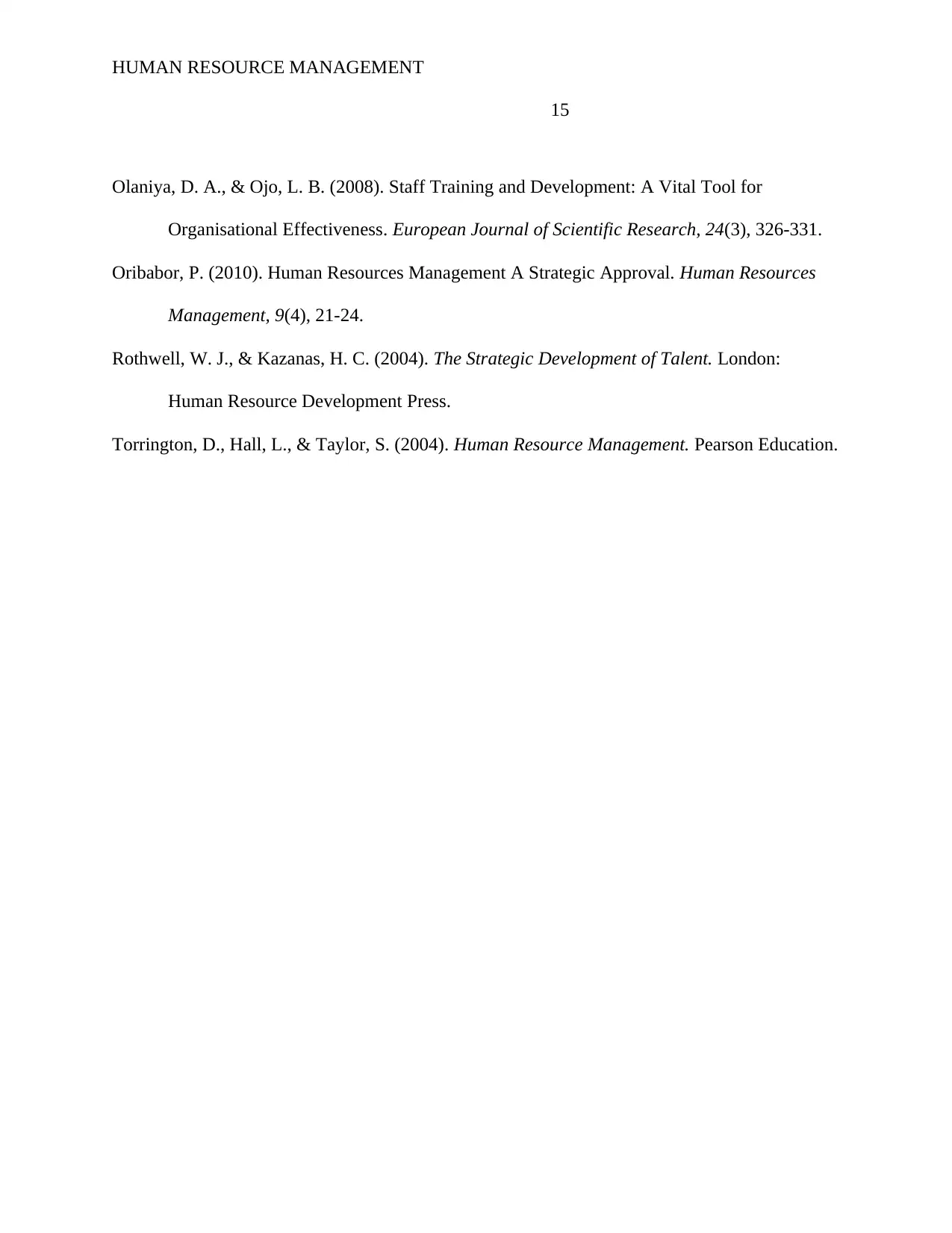
HUMAN RESOURCE MANAGEMENT
15
Olaniya, D. A., & Ojo, L. B. (2008). Staff Training and Development: A Vital Tool for
Organisational Effectiveness. European Journal of Scientific Research, 24(3), 326-331.
Oribabor, P. (2010). Human Resources Management A Strategic Approval. Human Resources
Management, 9(4), 21-24.
Rothwell, W. J., & Kazanas, H. C. (2004). The Strategic Development of Talent. London:
Human Resource Development Press.
Torrington, D., Hall, L., & Taylor, S. (2004). Human Resource Management. Pearson Education.
15
Olaniya, D. A., & Ojo, L. B. (2008). Staff Training and Development: A Vital Tool for
Organisational Effectiveness. European Journal of Scientific Research, 24(3), 326-331.
Oribabor, P. (2010). Human Resources Management A Strategic Approval. Human Resources
Management, 9(4), 21-24.
Rothwell, W. J., & Kazanas, H. C. (2004). The Strategic Development of Talent. London:
Human Resource Development Press.
Torrington, D., Hall, L., & Taylor, S. (2004). Human Resource Management. Pearson Education.
1 out of 15
Related Documents
Your All-in-One AI-Powered Toolkit for Academic Success.
+13062052269
info@desklib.com
Available 24*7 on WhatsApp / Email
![[object Object]](/_next/static/media/star-bottom.7253800d.svg)
Unlock your academic potential
© 2024 | Zucol Services PVT LTD | All rights reserved.




